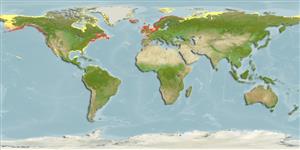Gastropoda |
Nudibranchia |
Onchidorididae
Environment: milieu / climate zone / djupintervall / distribution range
Ekologi
; djupintervall 0 - 64 m (Ref. 3446). Temperate; 85°N - 18°N, 180°W - 40°E
Eastern Pacific, Atlantic Ocean and the Arctic: northern Europe.
Length at first maturity / Size / Weight / Age
Könsmognad: Lm ? range ? - ? cm Max length : 1.4 cm TL hane/ej könsbestämd; (Ref. 822)
Assumed maximum length from Ref. 822. Found on and under rocks and kelp covered with bryozoans (Ref. 7726). Feeds on encrusting bryozoans (Ref. 822).
Life cycle and mating behavior
Könsmognad | Reproduktion | Lek | Eggs | Fecundity | Larvae
Members of the order Nudibranchia are simultaneous hermaphrodites. Mating behavior: Both individuals darts their penis toward each other to induce one to act as a male and the other as the female. The victorious one to penetrate the body wall is the dominant male. Life cycle: Eggs are deposited on a substratum where they develop and hatch into (planktonic) vestigial veliger larval stage and further grow as adults.
Behrens, D.W. and A. Hermosillo 2005 Eastern Pacific Nudibranchs: A guide to the Opisthobranchs from Alaska to Central America. Sea Challengers. Monterey, CA. 137 p. (Ref. 822)
IUCN Red List Status
(Ref. 130435: Version 2025-1)
CITES status (Ref. 108899)
Not Evaluated
Not Evaluated
Threat to humans
Human uses
| FishSource |
Verktyg
Ytterligare information
Trophic EcologyFood items (preys)
Födosammansättning
Födointag
Predatorer
Population dynamicsTillväxtMax. ages / sizesLength-weight rel.Length-length rel.Length-frequenciesMass conversionAbundans PhysiologySyreförbrukning
Human RelatedStamps, coins, misc.
Internet-källor
Estimates based on models
Preferred temperature
(Ref.
115969): 4.1 - 13, mean 9.5 (based on 792 cells).
Fishing Vulnerability
Low vulnerability (10 of 100).
Price category
Unknown.
